Hypothesis Testing
1/78
There's no tags or description
Looks like no tags are added yet.
Name | Mastery | Learn | Test | Matching | Spaced |
|---|
No study sessions yet.
79 Terms
Hypothesis Testing
Uses sample data to make inferences about the population from which the sample was taken
Assumes that the null hypothesis is true (if data is different from what is expected then null hypothesis rejected)
it asks only whether the population parameter differs from a specific “null” expectation using probability
basically put assumptions about a population parameter to the test
Ex: Instead of the estimation of how large is the effect it asks “Is there any effect at all?”
Making Statistical Hypotheses
Uses two clear hypotheses statements: the null hypothesis and the alternative hypothesis
hypothesis about a population
Null Hypothesis (H0)
The default hypothesis, It is a specific claim about the value of a population parameter
statement of equality where there is no difference, effect or chance (population parameter of interest is zero)
Identifies one particular value for the parameter being studied
Wants to be rejected to provide support for alternative research hypothesis
Alternative Hypothesis (HA or H1)
Includes every other possibility (parameter values) except for the one stated in the null;
opposite of null and is nonspecific
often the statement researcher hopes is true
Mutually Exclusive Hypothesis
One of the 2 hypotheses (alternative or null) is true and the other must be false
analyze data to determine which is which
Two-Tailed (Non-Directional) Alternative Hypothesis (H1)
States that there IS an effect or difference but doesn’t specify the direction of the effect
used when testing for any significant difference (increase or decrease)
the significance level is divided between both tails of the distribution
One-Tailed (Directional) Alternative Hypothesis (H1)
States that there IS an effect and also specifies the DIRECTION of the effect
used when testing for either an increase or decrease BUT NOT BOTH
one-tailed: the new drug increase bp, or the new drug decreases bp
the significance level is placed in one tail of the distribution
To reject or not to reject
Fail to reject the null hypothesis: means we technically “accept” the null hypothesis with data being consistent with it
Reject the null hypothesis: the data is inconsistent with the null hypothesis so reject it and support alternative hypothesis (H1)

Hypothesis Testing Steps
State the hypotheses
Compute the test statistic with the data
Determine the p-value
Draw the appropiate conclusion / make the decision of reject or fail to reject
Test Statistic
Number calculated from the data & is used to evaluate the results
it is compared with what is expected under the null hypothesis
Null Distribution
The range of values that support the null hypothesis and assume it is true (not an exact value)
we determine the sampling distribution of the test statistic by assuming that the null hypothesis is true
the alpha value is both significance levels (the values that reject the null) added
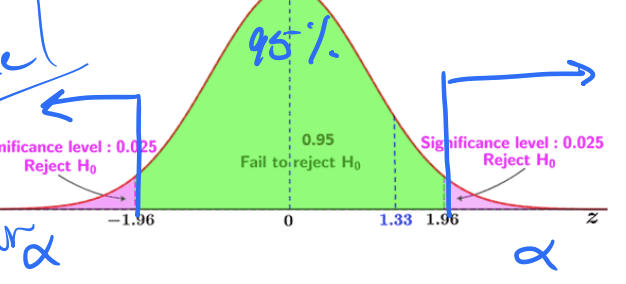
The P-value
The probability or likelihood of obtaining data more extreme/atypical than the data assuming the null hypothesis is true
the probability of obtaining an extreme result
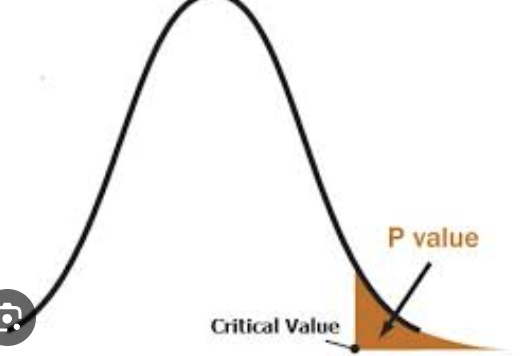
Small probability values (smaller p-value)
the null hypothesis is inconsistent with the data and we reject it in favor of the alternative hypothesis
basically stronger evidence against the null hypothesis and we reject it
HAPPENS WHEN P < .05
High probability values
Not enough evidence to reject the null hypothesis
sample means close to H0 and states that the H0 (null) is true
Making A Decision
If the p-value is small, it lands in the critical region ( < 5%) causing a rejection of the null hypothesis (H0)
the boundary is ( P < 0.05) to reject null = alpha level or level of significance ( α )
Null Distribution
Represents the distribution of a test statistic (e.g. mean difference, t-value, z-score) under the assumption that the null is true
it is a bell-shaped curve (like standard normal distribution)
Confidence Interval (CI)
provides a range of plausible values for a population parameter (e.g., mean or proportion)
typically constructed using sample data
Fail to Reject H0 with Confidence Interval (CI)
If it includes the null hypothesis value ( 0 for mean difference or 1 for odds ratio)
the observed results isn’t significantly different from null expectation
Reject H0 with Confidence Interval (CI)
if the CI doesn’t include the null hypothesis
suggests a statistically significant effect
Graphical Interpretation
confidence interval of 95%
for two tailed hypothesis test, the significance level (or α level) is at 0.05
the critical values from the null distribution (both sides at + or - 1.96 z value) determine the cutoff pts for the CI & hypothesis test
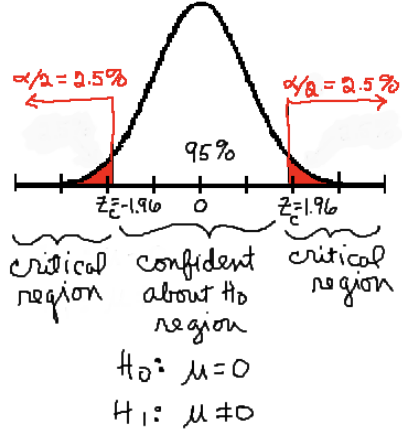
Errors in Hypothesis Testing
Chance can affect samples & some uncertainty cant be quantified
rejected the H0 doesn’t mean the null is false and failing to reject the null doesn’t mean it is true
two types of errors: TYPE I ERRORS, AND TYPE II ERRORS
Critical Values
The cutoff pts from the null distribution that determine rejection regions based on the chosen significance level ( α )
defines the rejection region for null hypthesis
if test statistic exceeds a critical value, H0 rejected
Used to construct the Ci & determine the p-value threshold for significance
Type I Error
False Positive Probability = α
Null hypothesis states to be true but it is actually rejected (false positive)
The incorrect rejection of a true null hypothesis
alpha level tells the probability of committing a type I error (if alpha = 0.05 then we would mistakenly reject is 5% or 1/20)
Type II Error
False Negative Probability = β
Null hypothesis stated to be false but it is actually not rejected (accepted)
Failing to reject a false null hypothsesis
if a null is false we need to reject it
How to reduce type I error rate
By using a smaller alpha value
has the side effect of increasing the chance of committing type II error
reducing alpha makes the null more difficult to reject when true but also makes it more difficult to reject when false
False Positive (Type I Error)
Occurs when a test incorrectly indicates the presence of a condition when it is actually absent
test incorrectly classifies a negative case as positive

Power
Probability found in Type II error that states random sample taken from a pop will, when analyzed, lead to rejection of a false null)
quantified using alpha level, sample size, effect size, & the number of tails in a test
Power = 1 - β

False Negative (Type II error)
Occurs when a test fails to detect a condition that is actually present
the test incorrectly classifies a positive case as negative

Sensitivity (True Positive Rate, Recall)
Measures the ability of a test to correctly identify those with the condition
portion of actual positives that are correctly identified as positives
MEASURE OF TEST ACCURACY (TELLS HOW WELL A TEST DETECTS TRUE POS)

Higher Sensitivity
Fewer false negatives
sensitivity tells how well the DS test detects DS when it is actually present
Recall
It measures how well the test recalls all true positive cases
another term for sensitivity
Specificity (true negative rate)
Measures the ability of a test to correctly identify those without the condition
portion of actual negatives correctly identified as negative

Higher Specificity
Fewer false positives
tells how well the DS test avoids falsely diagnosing DS when it is actually absent
Statistical Power
Measures the probability of correctly rejecting a false null hypothesis
power is the probability of avoiding a false neg
Ex: detecting an effect when one truly exists
Are sensitivity & power the same?
Conceptually similar (both measure the ability to detect a true pos) but applied in different contexts
sensitivity used in diagnostic tests (medical testing, calssification problems)
Power is used in hypothesis testing (experiments, stats studies)
They are the same in the context of diagnostic tests
Prevalence
the portion of a population that has a specific condition or disease at a given time
typically expressed as a percentage or as a fraction per 1000 or 100,000 people (depending on the context)
Ex: Prevalence of DS = 1 in 1000 pregnancies ( for every 1000 pregnancies, 1 has DS = 0.1%)

True Positive (TP)
Sensitivity x Total # of Cases
the cases where the test correctly identifies DS
False Negatives (FN)
( 1 - Sensitivity) x Total # of Cases
cases where the test fails to detect DS
False Positive (FP)
False Positive Rate x Total Non # of a Certain Case
ex: Total non-DS cases = 999,000 if 1 in every 100,000 children born has DS
Cases where the test incorrectly identifies a normal pregnancy as having DS
True Negatives (TN)
(1 - False Positive Rate) x Total Non-DS Cases
the cases where the test correctly identifies a normal pregnancy
Sensitivity (True Positive Rate)
Tells how well the test detects DS when it is actually present
Sensitivity = TP / Total Actual Positives (TP + FN)
Specificity (True Negative Rate)
Tells how well the test correctly identifies pregnancies that DO NOT have
Specificity = TN / TN + FD
Power in diagnostic testing
Power is Equivalent to sensitivity because it represents the ability of the test to detect a true condition
power = sensitivity in diagnostic testing (LIKE DS)
Goodness-of-fit Test
Method for comparing an observed frequency distribution w/ the frequency distribution that would be expected under a simple probability model governing the occurrence of diff outcomes
statistical test to determine if sample data is accurate or skewed
Compares observed data to expected data
Chi-Square goodness of fit test
used to determine whether a categorical variable follows a hypothesized distribution
observed frequencies vs expected frequencies of a categorical variable
Expected Frequencies
Expected proportion * N
sum of the expected values should be the same as the sum of the observed values (given rounding error)
Chi-square (χ^2) test statistic
Measures the discrepancy btwn the observed & expected frequencies
Observed = frequency of individuals observed in the __th category
Expected = frequency expected in that category under the null
Numerator = difference btw the data & what was expected
WHEN THE DATA PERFECTLY MATCHES EXPECTATIONS OF THE NULL THEN THE X2 VALUE IS ZERO
any deviation leads to x2 > 0
x2 uses absolute frequencies for observed & expected NOT the proportions of relative frequencies

The Chi-square distribution
It is a right-skewed distribution that allows only non-neg values
has large counts condition (at least 5)
It is a family of density curves
The distribution is specified by its degrees of freedom (df)
Chi-square degrees of freedom = # of categories - 1
Assumptions of the x2 goodness-of-fit test
assumes that the individuals in the data set are a random sample from the whole pop
each individual was chosen independently of all others & each member of the pop was equally likely to be selected for the sample
x2 statistic distribution
Follows a x2 distribution only approximatley
should have an expected frequency less than 5
no more than 20% of the categories should have expected frequencies les than 5
IF CONDITIONS NOT MET, TEST BECOMES UNRELIABLE
Degrees of freedom
Based on which analysis being conducted
# of independent pieces of info used to calculate a statistic
approximates the null hypothesis of independence
calculated by counting the (number of rows - 1) times (the number of columns - 1)
Chi-square contingency test
Displays how the frequencies of diff values for one variable depend on the value of another variable when both are categorical
determines whether, & to what degree, 2 or more categorical variables are associated
Helps decide whether the proportion of individuals falling into diff categories of a response variable differs among groups
DETERMINES WHETHER THERE IS A STATISTICALLY SIG DIFF BTWN EXPECTED FREQ & OBSERVED FREQ IN 1 OR MORE CATEGORIES OF A CONTINGENCY TABLE
Mosaic Plot
Visualize data from 2 or more qualitative variables
represented as rectangular areas
represents the relationship between two variables
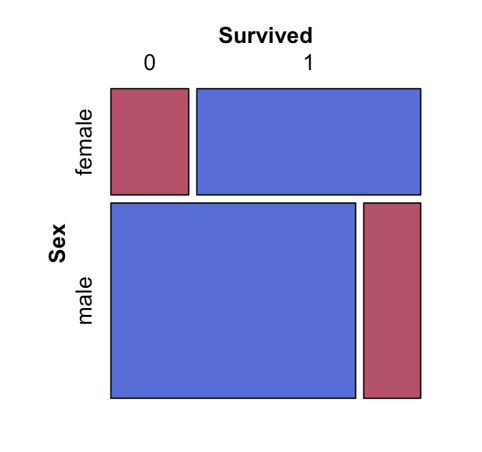
Independent Relationship Mosaic Plot
If the relationship btwn 2 variables is independent the bars would be equal in area
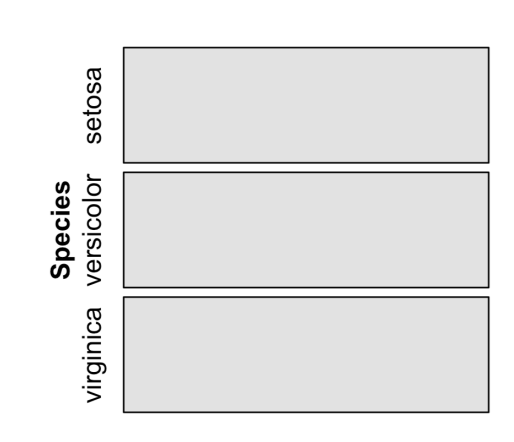
Estimating Association in 2 × 2 Tables: Relative risk
Relative risk is used to measure the association between an exposure & an outcome
calculated as the ratio of the probability of the outcome in the exposed group to the probability in the unexposed group
Relative risk is the probability of the undesired outcome in the first group / the probability in the other desired group

Relative Risk (RR) = 1
RR = 1, risk in exposed is equal to risk in unexposed (no association)
the null value for relative risk = indicates no difference between the groups
Relative Risk (RR) > 1
risk in exposed is greater than risk in unexposed (positive association, possibly casual)
Relative Risk (RR) < 1
risk in exposed less than risk in unexposed (negative association, possible protective)
Null value for risk difference
Is 0
CI doesn’t contain the Null value (RR = 1)
Can say the finding is statistically significant
if RR does not = 1 then findings are statistically significant (unlikely to have occurred by chance)
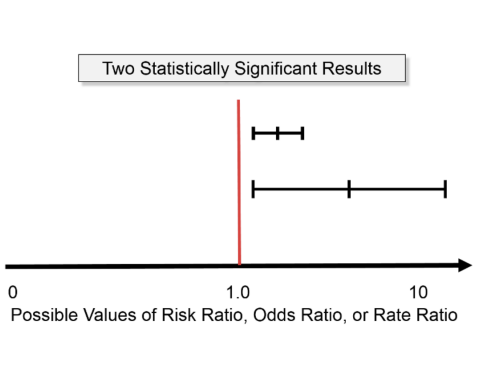
CI for the relative risk includes null vaue of 1 (RR = 1)
There isn’t sufficient evidence to conclude that the groups are statistically significantly different
If RR = 1 then the findings are not statistically significant (occurred by chance)

Reduction in Relative Risk (RR)
1 - RR ( 1 minus Relative Risk)
expresses the risk ratio as a percentage reduction
the difference in risk btwn the 2 groups w/ respect to the control group
The percentage decrease in risk caused by an intervention compared to a control group who didn’t have intervention
Reduction in Absolute Risk (ARR)
The risk in the control group minus the risk in the treatment group
actual difference in risk between the treated & the control group
Estimating Association in 2 x 2 tables: the odds ratio
Odds ratio measures the magnitude of association btwn 2 categorical variables when each variable only has 2 categories
one variable is the response variable (success & failure)
Second variable is the explanatory variable (idenitfies the 2 groups whose probability of success is being compared)
Compares the proportion of successes & failures btwn the 2 groups
Focal outcome
The primary or main outcome variable of interest in a study
Odds
The probability of success or failure where success refers to the focal outcome
The probability of success is p, probability of failure is 1 = p

If Odds = 1 (1:1)
One success occurs for every failure
Odds = 1 (10:1)
10 trials result in success for every one that results in failure
Odds ratio
The ratio of the odds of success btwn the 2 groups
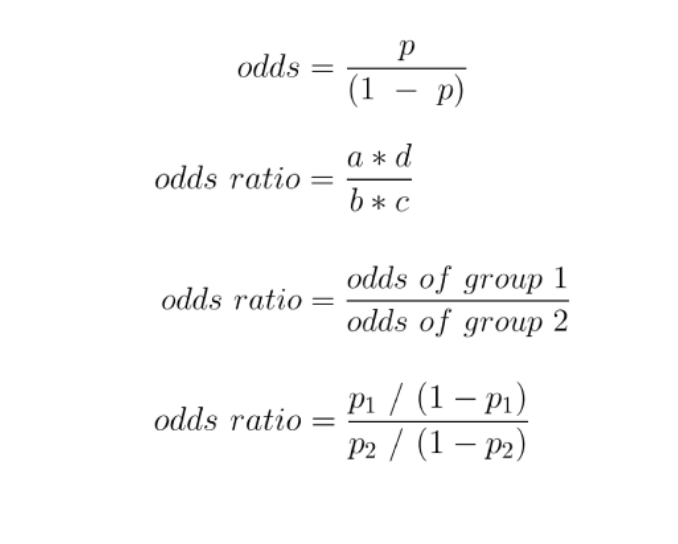
Odds ratio = 1
The exposure is NOT ASSOCIATED with the disease
Odds ratio > 1
The exposure may be A RISK FACTOR for the disease
Odds ratio < 1
The exposure may be PROTECTIVE against the disease
Odds ratio vs Relative Risk
RR is more intuitive than OR as it is the ratio of proportions
the values for the OR and RR will be similar whenever the focal outcome (outcome of the main variable) is rare
Odds Ratio Advantage
Can be applied to data from case control studies
Case Control study
method of observational study where a sample of individuals having a disease or other focal condition (cases) is compared to a second sample of individuals who don’t have the condition (controls)
the samples are otherwise similar in other characteristics that might also influence the results
The total # of cases & controls in the samples are chosen by the experimenter not by sampling at random in the pop
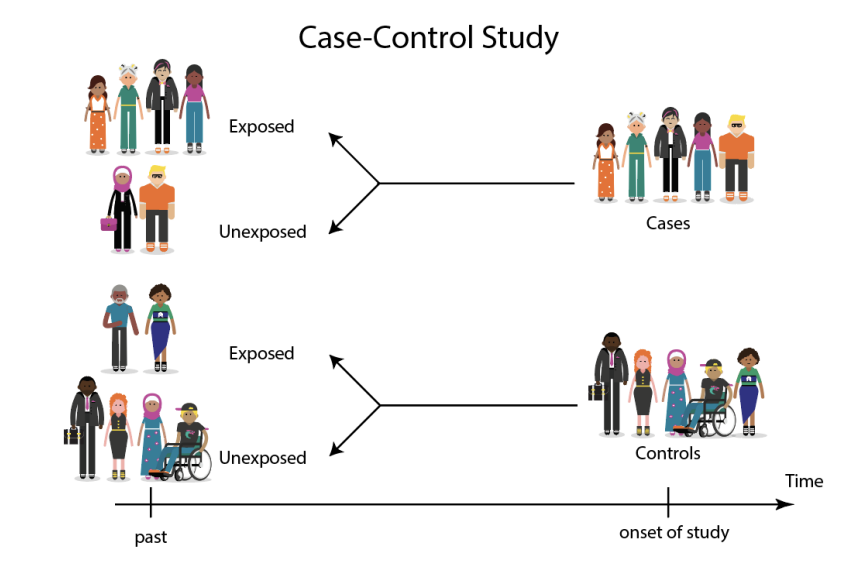
Chi-square contingency test
RR and OR allow to estimate the magnitude of association btwn 2 categorical variables
doesn’t allow us to directly test whether an association may be caused by chance alone
Used as a test of association btwn 2 categorical variables
tests the goodness of fit to the data of the null model of independence of variables
H0 on categorical variables
states that the categorical variables are INDEPENDENT
means the probability of one occurring is equal to the probability of one occurring times the probability of the other event occuring
H1, OR H1 on categorical variables
states the categorical variables are NOT INDEPENDENT
Fischer’s Exact Test
Provides an exact p-value for an estimate of association in a 2 × 2 contingency table
determines if there is a sig difference btwn 2 groups